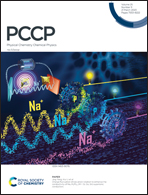When less is more: does more Na+-cations mean more adsorption sites for toluene in faujasites?†
Abstract
The unique properties of zeolites make them an interesting material to be used in separation processes. The possibility of tailoring some of their characteristics, like the Si/Al ratio, allows optimizing their synthesis for a given task. Concerning the adsorption of toluene by faujasites an understanding of the effect of cations is necessary to foster the elaboration of new materials, which can capture molecules with a high degree of selectivity and sensitivity. Undoubtedly, this knowledge is relevant for a wide range of applications going from the elaboration of technologies for improving the air-quality to diagnostic procedures to prevent health risks. The studies reported here using Grand Canonical Monte Carlo simulations elucidate the role of Na-cations in the adsorption of toluene by faujasites with different Si/Al ratios. They detail how the location of the cations inhibits or enhances the adsorption. The cations located at site II are shown to be those enhancing the adsorption of toluene on faujasites. Interestingly, the cations located at site III generate a hindrance at high loading. This becomes an impediment for the organization of toluene molecules inside faujasites.



 Please wait while we load your content...
Please wait while we load your content...